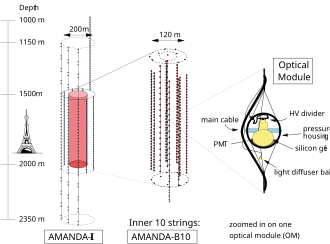Antarctic Muon And Neutrino Detector Array
AMANDA ( A ntarctic M uon a nd N eutrino D etector A rray ) was an in-ice "telescopic" high energy for detecting neutrinos . The telescope, operated from 1996 to May 2009, was located at the Amundsen-Scott South Pole Station in Antarctica . AMANDA was an international collaboration of institutes from the USA, Germany, Sweden, Belgium and Venezuela.
construction
AMANDA was not a telescope in the traditional sense, but an array (field) of cylindrically arranged strands with signal cables to which numerous optical modules ( photomultipliers ) are attached. The optical modules were located in the ice at depths of around 1,000 to 2,350 m.
- AMANDA-B4 (1996): 86 optical modules on 4 lines. First expansion stage of AMANDA-B-10 (inner area)
- AMANDA-B10 (1997): 302 optical modules on 10 strands. Central area of the instrumented cylinder: 500 m high × 120 m diameter
- AMANDA-B13 (1998): 426 optical modules on 13 strings. First expansion stage of AMANDA-II with optical modules above and below the central area
- AMANDA-II (2000): 677 optical modules on 19 lines. Central area of the instrumented cylinder: 500 m high × 200 m diameter
The follow-up experiment is the IceCube neutrino detector , completed on December 18, 2010 , which consists of 5160 sensors on 86 strings and has a total volume of 1 km³.
Method and successes
The neutrinos were detected by detecting Cherenkov radiation from charged relativistic elementary particles such as muons . These particles are created by collisions between neutrinos and atomic nuclei in the ice. From the arrival time of the Cherenkov light captured with nanosecond accuracy (optical part of Cherenkov radiation), conclusions could be drawn about the direction of the neutrinos that had fallen.
With AMANDA it was possible for the first time to measure high-energy atmospheric neutrinos in large numbers in the wild.
The detector was also part of the Supernova Early Warning System .
Web links
Individual evidence
- ↑ a b c J. Ahrens, X. Bai, R. Bay, SW Barwick, T. Becka: Muon track reconstruction and data selection techniques in AMANDA . In: Nuclear Instruments and Methods in Physics Research Section A: Accelerators, Spectrometers, Detectors and Associated Equipment . tape 524 , no. 1-3 , p. 169–194 , doi : 10.1016 / j.nima.2004.01.065 ( elsevier.com [accessed September 7, 2017]).
- ↑ E. Andres, P. Askebjer, X. Bai, G. Barouch, SW Barwick: Observation of high-energy neutrinos using Cerenkov detectors embedded deep ice in Antarctic . In: Nature . tape 410 , no. 6827 , p. 441-443 , doi : 10.1038 / 35068509 ( nature.com ).
